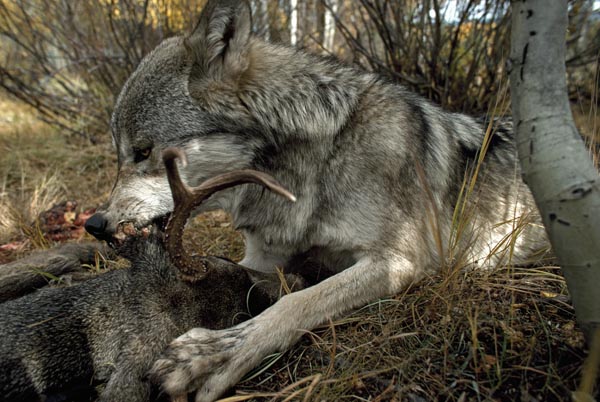Gray Wolf
| https://www.nationalgeographic.com/animals/mammals/g/gray-wolf/ |
Taxonomy
Rank
Kingdom :Animalia
Phylum :Chordata
Class :Mammalia
Order :Carnivora
Family :Canidae
Genus :Canis
Species :C. lupus
Anatomy:
1.Weight
Male: 80-110 lbs.
Female: 60-80 lbs.
2.Height
26 to 32 inches.
3.Length
Male: 5-6.5 feet (nose to tip of tail).
Female: 4.5 to 6 feet.
Habitat : Arctic
tundra, Forest, Prairie, and deserts.
Diet : Carnivore.Wolf
can consume up to 9 kg of meat at one meal.
Life
Cycle :
Lifespan:
7-8 years in the wild. 12 years or more in remote or protected areas.
Mating
Season: January or February.
Gestation:
63 days.
Litter size: 4-7 pups.
Habit:
1.Travel
and hunt in packs of 7 to 8 animals on average.
2.Travel
in search of prey through their power of scent, chance encounter, and tracking.
3.Gray wolves howl to assemble the pack (usually
before and after hunts), to pass on an alarm (particularly at a den site), to
locate each other during a storm or unfamiliar territory and to communicate
across great distances.
The
wolf (Canis lupus), also known as the gray wolf, timber wolf, western wolf, and
its other subspecies is a canine native to the wilderness and remote areas of
Eurasia and North America. It is the largest extant member of its family, with
males averaging 43–45 kg (95–99 lb) and females 36–38.5 kg (79–85 lb). Like the
red wolf, it is distinguished from other Canis species by its larger size and
less pointed features, particularly on the ears and muzzle. Its winter fur is
long and bushy and predominantly a mottled gray in color, although nearly pure
white, red, and brown to black also occur. Mammal Species of the World (3rd
ed., 2005), a standard reference work in zoology, recognises 38 subspecies of
C. lupus.
The
gray wolf is the largest extant member of the Canidae, excepting certain large
breeds of domestic dog. Gray wolf weight and size can vary greatly worldwide,
tending to increase proportionally with latitude as predicted by Bergmann's
Rule, with the large wolves of Alaska and Canada sometimes weighing 3–6 times
more than their Middle Eastern and South Asian cousins. On average, adult
wolves measure 105–160 cm (41–63 in) in length and 80–85 cm (31–33 in) in
shoulder height. The tail measures 29–50 cm (11–20 in) in length. The ears are
90–110 mm (3.5–4.3 in) in height, and the hind feet are 220–250 mm (8.7–9.8 in).
The mean body mass of the extant gray wolf is 40 kg (88 lb), with the smallest
specimen recorded at 12 kg (26 lb) and the largest at 79.4 kg (175 lb). Gray
wolf weight varies geographically; on average, European wolves may weigh 38.5
kg (85 lb), North American wolves 36 kg (79 lb) and Indian and Arabian wolves
25 kg (55 lb). Females in any given wolf population typically weigh 5–10 lb (2.3–4.5
kg) less than males. Wolves weighing over 54 kg (119 lb) are uncommon, though
exceptionally large individuals have been recorded in Alaska, Canada, and the
forests of western Russia. The heaviest recorded gray wolf in North America was
killed on 70 Mile River in east-central Alaska on July 12, 1939 and weighed
79.4 kg (175 lb).
:max_bytes(150000):strip_icc()/GettyImages-539044748-a1391dec56bc4e61ae19c6e4e749b2d3.jpg) |
| https://www.thoughtco.com/profile-of-the-gray-wolf-1203621 |
The
gray wolf is a habitat generalist, and can occur in deserts, grasslands,
forests and arctic tundras. Habitat use by gray wolves is strongly correlated
with the abundance of prey, snow conditions, absence or low livestock
densities, road densities, human presence and topography. In cold climates, the
gray wolf can reduce the flow of blood near its skin to conserve body heat. Gray
wolves use different places for their diurnal rest: places with cover are
preferred during cold, damp and windy weather, while wolves in dry, calm and
warm weather readily rest in the open. During the autumn-spring period, when
wolves are more active, they willingly lie out in the open, whatever their
location. Actual dens are usually constructed for pups during the summer
period. When building dens, females make use of natural shelters such as
fissures in rocks, cliffs overhanging riverbanks and holes thickly covered by
vegetation.
 |
| https://www.livingwithwolves.org/how-wolves-hunt/ |
Gray
wolves are carnivorous they primarily eat meat. Wolves often hunt in packs for
large prey such as deer, moose, sheep, goats, caribou, elk, bison, and muskox.
Wolves also will prey on rodents, beavers, fish, and birds.
 |
| https://www.kqed.org/news/11757248/wolf-pups-emerge-from-den-at-oakland-zoo |
Breeding
season occurs once a year late January through March. Pups are born blind and
defenseless. The pack cares for the pups until they fully mature at about 10
months of age when they can hunt on their own. Once grown, young wolves may
disperse. Dispersing wolves have been known to travel 50 to 500 miles.
Mating Season: January or February.
Gestation: 63 days
Litter size: 4-7 pups
 |
| https://www.ncwlife.com/wdfw-kills-remaining-members-of-opt-wolf-pack/ |
Wolves
live, travel and hunt in packs of 7 to 8 animals on average. Packs include the
mother and father wolves (called the alphas), their pups and older offspring.
The alpha female and male are typically the pack leaders that track and hunt
prey, choose den sites and establish the pack's territory. Wolves develop
strong social bonds within their packs.
Wolves have a complex communication system ranging from barks and whines
to growls and howls. While they don't actually howl at the moon, they are more
active at dawn and dusk, and they do howl more when it's lighter at night,
which occurs more often when the moon is full.
Power Point
Power Point
Source : - https://en.wikipedia.org/wiki/Wolf
- https://animaldiversity.org/accounts/Canis_lupus/
Comments
Post a Comment